Sakina liebt Vögel und hatte Papageien und Wellensittiche als Haustiere. Jetzt hat sie zwei Turteltauben, von denen einer ein pfirsichgesichtiges Männchen ist, das sie von Hand aufgezogen hat.
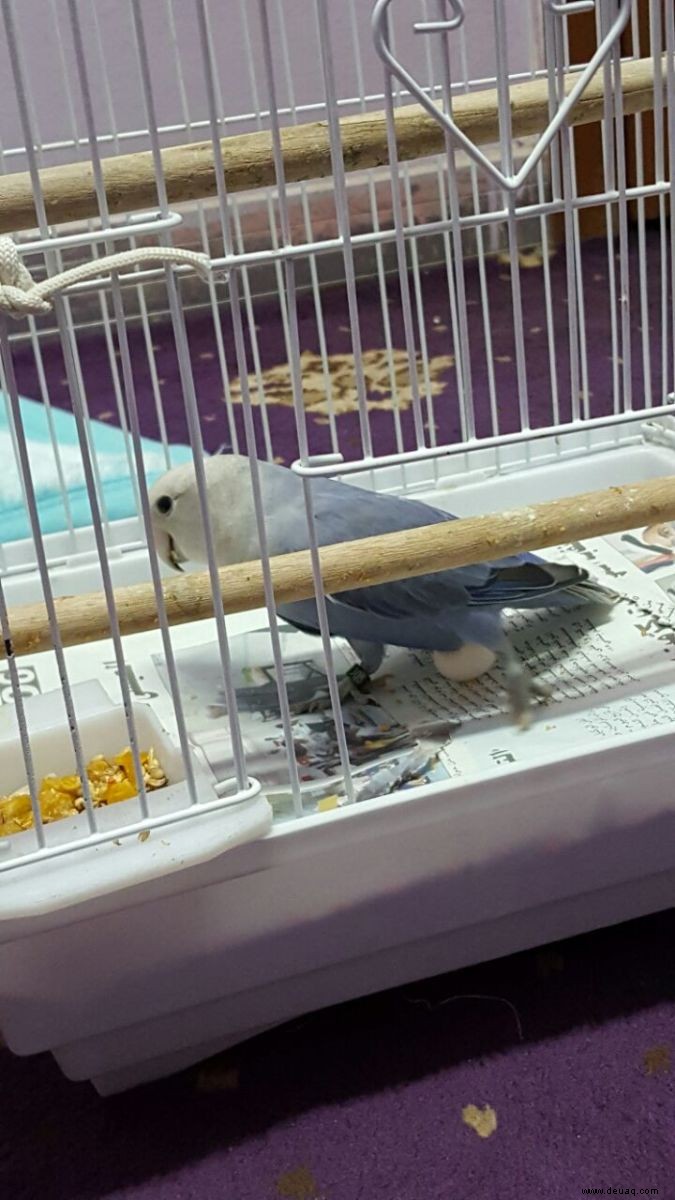
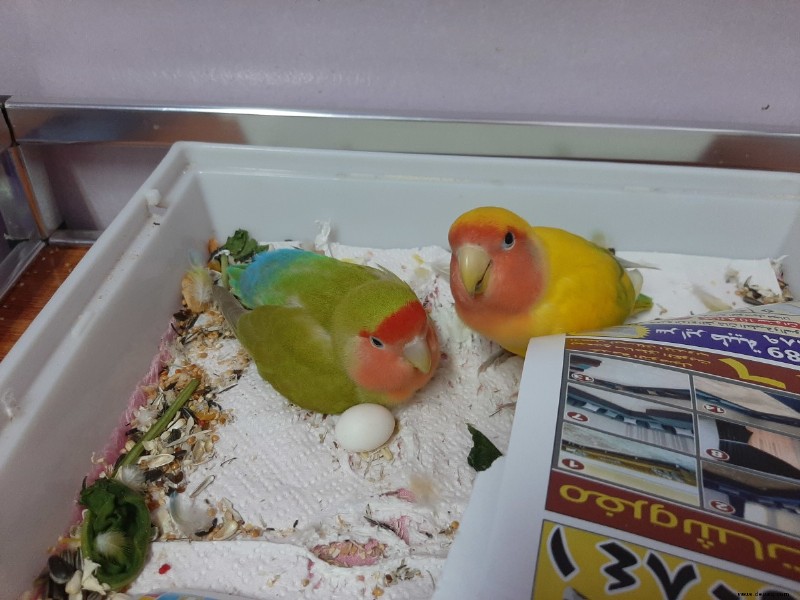
Lovebirds Egg Brutzeit
In diesem Artikel werden die folgenden häufig gestellten Fragen und Themen zur Eiablage bei Unzertrennlichen ausführlich behandelt.
- Wann legt ein Unzertrennliches Weibchen ein Ei?
- Wie viele Eier legt ein Unzertrennliches Weibchen?
- Anzeichen eines schwangeren Lovebirds
- Einen geeigneten Nistkasten finden
- Nistmaterial für Unzertrennliche
- Eierbindung bei Unzertrennlichen
- Kalziumvorrat für Ihre Turteltauben (Tabelle)
- Ein gesundes Rezept für Unzertrennliche
- Unfruchtbarkeit bei Lovebirds
- Was sind die Ursachen für Unfruchtbarkeit?
Wann legt ein weiblicher Unzertrennlicher ein Ei?
Viele unerfahrene Züchter haben diese Frage irgendwann im Kopf. Ein weiblicher Unzertrennlicher legt ein Ei mit oder ohne Partner, wenn sie etwa 9–12 Monate alt ist. Ohne einen Partner sind die gelegten Eier natürlich unfruchtbar. Manchmal kaufen Leute am Ende zwei Weibchen oder zwei Männchen. Die gemeinsame Unterbringung kann im ersten Fall zu einem Gelege mit unbefruchteten Eiern oder im zweiten Fall zu keinen Eiern führen.
Wenn die Paarung zwischen einem echten Lovebird-Paar (Männchen und Weibchen) stattfindet, sind die gelegten Eier befruchtet – obwohl auch unbefruchtete Eier möglich sind, wie im Fall meiner Haustiere Mumu und Lulu.

Wie viele Eier legt ein weibliches Unzertrennliches?
Die Eier werden innerhalb von 7–10 Tagen nach der Paarung gelegt. In meinem Fall hat Lulu genau eine Woche später, am 6. Oktober 2016, ein Ei gelegt. Interessanterweise hatten wir keine Ahnung, dass sie schwanger war! Normalerweise legt eine Henne (weiblicher Lovebird) ein Gelege mit 4–6 Eiern in einem Abstand von 1–2 Tagen. Sie brütet dann über den Eiern, normalerweise nachdem sie das ganze Gelege gelegt hat.
Die Inkubationszeit beträgt 21–23 Tage, danach werden die Küken geschlüpft. Es kann auch Ausnahmen geben. Die Küken können sogar bis zum 24. oder 25. Tag schlüpfen. Achten Sie darauf, die Tage zu zählen, damit Sie das Schlupfdatum ungefähr berechnen können.
Lulu hatte jeden zweiten Tag ununterbrochen vier Eier gelegt. Dann, nach einer Pause von 7–10 Tagen, hatte sie fünf weitere Eier gelegt.
Anzeichen eines schwangeren Lovebird
- Sie geht langsam.
- Sie kann nicht fliegen/fliegt nur schwer.
- Sie zeigt eine leichte Gewichtszunahme.
- Ihr Körper zeigt einen deutlichen „Babybauch.“
- Sie sieht müde aus.
- Sie schläft viel und schüttelt ihre Federn.
- Das Männchen füttert sie rigoros.
- Sie wedelt vielleicht mit dem Schwanz.
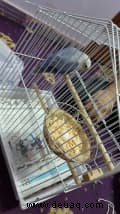


Wir haben ein Kanarienvogelnest gekauft, in der Annahme, dass es vorher ein Lovebird-Nest war.
1/2Einen geeigneten Nistkasten finden
Ein Nistkasten ist ein wesentlicher Bestandteil in der Lovebird-Zucht. Als wir erfuhren, dass Lulu ein Ei gelegt hatte, kauften wir sofort einen Nistkasten. Der Tierhalter hatte irrtümlicherweise ein rundes Nest aus Stahl geschenkt, das eigentlich für Kanarienvögel gedacht war. Beim Surfen im Internet wurde mir klar, dass Unzertrennliche Nistkästen aus Holz brauchen. Der Austausch erfolgte, und wir kauften einen kleinen Nistkasten/ein englisches Wellensittichnest, das meine Turteltauben bereitwillig annahmen. Denken Sie daran, Ihren Haustieren Nistmaterial zur Verfügung zu stellen.
Aufstellen des Nistkastens
- Der Nistkasten kann außerhalb des Käfigs aufgestellt und an der Käfigwand befestigt werden.
- Den Nistkasten innen befestigen (mit S-förmigen Haken)
Meiner Meinung nach ist es besser, den Nistkasten drinnen zu platzieren. Meine Haustiere lieben es, zusammen in der Box zu sitzen, um sich zu wärmen. Manchmal dösen sie auch darin ein, weil es hier kalt ist. Sie können es jedoch nach Ihren Wünschen platzieren.
(P.S. Sie können den Nistkasten platzieren, wo immer Sie möchten, je nachdem, wie es Ihrem Haustier geht. Dafür gibt es keine feste Regel!)
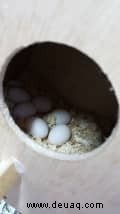


Bild zeigt die Eier meines Turteltaubens Lulu, die in ihren Nistkasten gelegt wurden.
1/2Nistmaterial für Lovebirds
Lovebirds benötigen Nistmaterial, um ihre Nester zu bauen. Diese werden benötigt, um die Feuchtigkeit im Nest zu halten, da sie für die Eiablage unerlässlich ist. Sowohl Männchen als auch Weibchen machen lange Streifen aus allem verfügbaren Material und tragen sie in den Nistkasten. Während das Weibchen sie in ihre Flügel und ihren Schwanz steckt, versucht das Männchen dasselbe zu tun, bleibt jedoch oft erfolglos. Es kann jedoch Ausnahmen geben (Mumu hat die Fähigkeit gemeistert, Papier zu zerkleinern und es in seinen Schwanz zu stecken)!
Was kann in Nesting-Materialien aufgenommen werden?
Sie können Nistmaterial in einem örtlichen Tiergeschäft kaufen oder Folgendes bereitstellen:
- Palmblätter (Lulu liebt diese einfach)
- Papierhandtücher
- Getrocknetes Gras
- Lovebirds eigene Federn (verlorene)
- Blätter von ungiftigen Pflanzen (unzertrennlich)
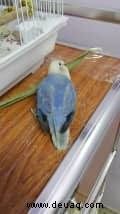


Lulu, mein weiblicher Lovebird, liebt es, Palmblätter zu zerkleinern und sie in ihren Schwanz zu stecken. Es ist das perfekte Nistmaterial für sie.
1/2Eibindung bei Lovebirds
Das häufigste Problem bei der Eiablage bei Unzertrennlichen ist die Eibindung. Dies bedeutet, dass Ihr Vogel ein Ei nicht leicht passieren kann. Dies kann für Ihren Vogel tödlich sein. In diesem Fall muss sofort ein Tierarzt aufgesucht werden. Wenn kein Tierarzt konsultiert werden kann, können Sie einige Dinge tun, um Ihrem Vogel zu helfen, das Ei auszustoßen.
In meinem Fall hatte Lulu problemlos 9 Eier bestanden. Das 10., 11. und 12. Ei wurde mit Mühe in einem Abstand von 5–7 Tagen passiert. Sie hielt sich nicht gut, fing an zu erbrechen und schlief viel. Sie blieb einen Tag so. Am nächsten Tag würde ihr Ei ausgeschieden und sie wäre wieder normal und aktiv.
Anzeichen der Eierbindung
- Belasten
- Aufgeplusterte Federn
- Am Boden des Käfigs sitzen
- Schwanzwippen
- Schwierigkeiten beim Atmen
- Schwäche
- Appetitlosigkeit
- Großer Kot/Minimaler Kot
- Viel schlafen (in Lulus Fall)
- Erbrechen (in Lulus Fall)
- Fieber (in Lulus Fall)
Ei-Bindung zu Hause beheben
- Legen Sie den Vogel auf ein warmes Handtuch (Wärme ermöglicht die Dehnung der Muskeln und hilft so beim Ablegen des Eies.)
- Legen Sie den Vogel in eine Schüssel mit warmem Wasser. Ihr Vogel wird das Ei wahrscheinlich im Wasser weitergeben.
- Kalziumversorgung geben (zerstoßene Eierschalen und kleine Eiweißstücke).
- Wenn Ihr weiblicher Vogel nicht frisst, füttern Sie das Männchen mit der oben erwähnten Kalziumzufuhr.
- Gib viel Ruhe ohne Störungen.
- Halten Sie den Käfig zum Wärmen mit einer Decke bedeckt.
- Halte den Käfig sauber. Ihr Vogel wird wahrscheinlich großen Kot ausscheiden, der den Käfigboden durchnässen und es kälter machen kann.
So verwenden Sie Ei als schnelle Kalziumversorgung für Unzertrennliche:Foto-Tutorial
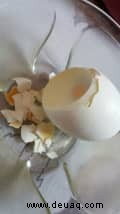




Ein Ei kochen. Eierschale und Eiweiß in kleine Stücke zerstoßen. Bieten Sie dies Ihren Turteltauben an, da es eine reichhaltige Kalziumquelle ist. Dies hilft auch sehr bei eiergebundenen Weibchen.
1/4Nahrungsmittel mit Kalzium für Ihre Lovebirds
| Gemüse | Früchte | Andere |
|---|---|---|
| Brokkoli | Kiwi | Eierschale |
| Kohl | Getrocknete Feige | Eiweiß |
| Sellerie | Orange | Sonnenlicht |
| Blattkohl | Aprikose | UV-Licht |
| Chinakohl |
| Tintenfisch |
| Grünkohl |
| Mineralblock |
| Rucola |
|
|
| Kohlrabi |
|
|
| Senfgrün |
|
|
| Spinat |
|
|
Ein gesundes Rezept für Lovebirds
Zutaten
- 4–5 frische Blattspinat
- 1 ganzes Ei (Schale, Eigelb und Eiweiß werden verwendet)
- Frische Maiskörner
Anleitung
- 4–5 Blattspinat und ein Ei kochen
- Trockne die Spinatblätter in der Sonne und zerdrücke sie.
- Zerkleinern Sie einen Teil der Eierschale in kleine Stücke/Pulverform und fügen Sie sie hinzu.
- Nehmen Sie auch etwas Eigelb und Eiweiß.
- Nehmen Sie frischen Mais und trocknen Sie ihn, bis er ausgehärtet ist. Zerdrücken Sie sie in kleine Stücke und fügen Sie sie der Mischung hinzu.
- Werfen Sie alles weg und servieren Sie es Ihrem Haustier/Ihren Haustieren frisch. Entweder über den Futternapf streuen oder separat geben. Es lindert Schwäche und stärkt Ihren Vogel.
Unfruchtbarkeit bei Lovebirds
Unfruchtbarkeit kann bei einer Lovebird-Henne verursacht werden, wenn die Eier leer/ohne Küken bleiben. Dies ist bei meinem Vogel Lulu der Fall. Bis jetzt hat sie insgesamt 12 Eier gelegt, aber es sind keine Küken geschlüpft. Auf allen saß sie eine Weile, aber ihr Grübeln war nicht von Dauer. Es ist sehr traurig, ja, ich wollte schon immer sehen, welche Farbe ihre Küken vererben würden. Mein Unzertrennlicher Mumu ist ein mittelgrüner, schwer gescheckter Pfirsichgesichtiger, während die weibliche Lulu ein weißgesichtiger, violetter Roseicollis-Pfirsichgesichtiger Unzertrennlicher ist.
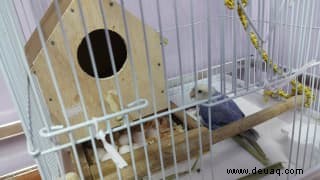


Wir hatten Lulus Eier in diese kleine quadratische Holzkiste gelegt und sie alle aus ihrem Nistkasten entfernt. Dies wurde gemacht, um zu überprüfen, ob Lulu auf ihren Eiern sitzt oder nicht. Ich glaube, dass eine Mutter weiß, dass ihre Eier nicht befruchtet sind, also hat sie sich nicht einmal darauf gesetzt.
1/2What Are the Causes of Infertility?
- Nutritional Factor: If the hen lacks minerals and calcium, her eggs will remain infertile. A healthy diet with all the essential minerals and calcium may help in reducing infertility.
- Loose Perches: Ensure that the perches are fixed firmly. The hen needs support to carry the male on her back. If the perches are loose, mating won't happen properly.
- Mutation: If your bird is a mutation, she may or may not be infertile.
- Age: If your bird is too young or too old, the eggs may remain infertile.
- Environmental Factors: There should be enough humidity for successful mating. Heaters and humidifiers may aid in creating such an atmosphere. A nest box is also very essential for mating.
Egg-Laying Is a Wonder
Lovebirds are a beautiful species and their reproduction and egg-laying process a wonder of nature. Unfortunately, I am not lucky enough to see the hatching of my pets' chicks. Nevertheless, I still hope that one day I might see their babies, hopefully.
Dieser Artikel ist nach bestem Wissen des Autors korrekt und wahrheitsgemäß. Es soll keine Diagnose, Prognose, Behandlung, Verschreibung oder formelle und individuelle Beratung durch einen Tierarzt ersetzen. Tiere, die Anzeichen und Symptome von Stress aufweisen, sollten sofort einem Tierarzt vorgestellt werden.
Fragen &Antworten
Frage: I have a female lovebird who lays eggs. The eggs are fertile but the chicks are not able to break the eggs and die inside. Why is this?
Antwort: This is a common issue in lovebirds. Survival is difficult, so the probability of hatching is less in most cases.
Frage: It’s almost a month why are my lovebirds' eggs not hatching?
Antwort: Your bird might be younger than one year of age, might not be mated well, or may be infertile. Please throw those eggs away. The hatching period is 21-25 days.
Frage: I have a female lovebird who has been laying eggs. Her mate died and she is not going in the nest. Was kann ich tun?
Antwort: Please get her a new mate.
Frage: Is it normal for a Lovebird to lay only one egg?
Antwort: Yes, it's perfectly okay. Sometimes, my bird laid one egg, at times 12 in succession.
Frage: I've heard from people that when you see a lovebirds' egg, they're most likely to throw them out of their nest. Is this true ?
Antwort: No, you can see their eggs, there's no problem in that. You shouldn't touch them, though.
Frage: My African Lutino lovebird laid four eggs, but they are not hatching after 30 days. This is first time she has laid eggs. Gibt es ein Problem?
Antwort: It's common in lovebirds to lay infertile eggs. There's nothing to worry about.
Frage: Why are my lovebirds mating but the female not laying eggs?
Antwort: They must either be young birds or it will take a while. Please wait till a week or 10 days for the female lovebird to lay eggs. If mating is not done properly, then eggs won't be laid.
Frage: Are you able to move the eggs or can you not move them at all?
Antwort: You can shift them with a spoon.
Frage: I have a female and a male lovebird, the female lovebird is old enough to lay eggs but doesn't. What should I do to help her?
Antwort: Please give her time. She might not be ready or they might be not be mates yet.
Frage: Can I look at my lovebirds' eggs?
Antwort: Yes, you can if your lovebirds lay them, but you shouldn't touch them.
Frage: My birds laid their eggs in coconut and now I'm not sure what to do. They had 6 eggs on the 6th of November and now they have 5 more. It's the 6th of December and none have them hatched yet. Why?
Antwort: Those eggs are infertile. I'm afraid they won't hatch. Please discard those 6 eggs.
Frage: Should I crack the lovebird egg? It is taking a long time and not cracking. My bird does not have a mate.
Antwort: No, you should not even touch the egg. Let the egg crack on its own. If it doesn't hatch within 21-25 days after the bird has laid it, you can discard it.
Frage: Can I move my love birds to a bigger cage while she is sitting on her eggs?
Antwort: Yes, you can do that. No worries.
Frage: My lovebird laid 4 eggs. 1 infertile. 3 fertile. The 3 actually have babies in them. She has been sitting on them. But it has been at least 3 weeks now. I think the chicks inside may be dead. Why would this be? When she's been looking after them nonstop?
Antwort: My lovebird used to do the same thing. Please wait for 4-5 days. If there are no hatchings, please discard the eggs.
Frage: My female lovebird had laid an egg in the breeding pot and I bought a bigger cage, can I shift them to a new cage?
Antwort: Yes, you can shift them.
Frage: My lovebird laid an infertile egg on the bottom of the cage with blood on it. Should I be worried she’s hurt?
Antwort: Please check your lovebird's bottom. Apply turmeric powder if there's a wound.
Frage: Will the lovebird lay second clutch and when?
Antwort: The female lovebird will lay a second clutch after she has incubated the first clutch. If there are hatchlings, she will take care of them. If not, you need to discard the eggs posterior 25 days of their laying.
Frage: My lovebird laid just one egg. One of her legs was broken when she was still a baby. She was a rescue bird. Everything is fine with her but she can’t move her leg properly. She laid her egg about 4 weeks ago and today I checked and saw it’s empty. My question is:how do I remove the egg without her being sad? And is it normal to just lay one egg? Her mate is healthy too.
Antwort: Please give her multivitamins. It's fine if she lays only one egg (mine did it too). Please remove it once no chicks hatch after 25 days of laying because the eggs turn bad then. She won't be sad. Please remove it for your birds' safety. If you think she might be aggressive/sad with the egg removal, please buy a dummy egg and place it near her.
Frage: Do lovebirds have egg laying problems?
Antwort: Ja, das tun sie. I mentioned infertility in lovebirds at the end of my article.
Frage: My lovebird's egg is out of the nest box. Can I put the egg back? Will the lovebird accept this egg?
Antwort: First place the egg back in the nest box and see if the mother lovebird accepts it or not.
Frage: My lovebird has only laid 2 eggs. This is her first time, is that normal? She is sitting on the eggs though.
Antwort: Yes, it's okay, give her time. She may lay more eggs. If not, it's okay.
Frage: Why are my lovebird's eggs not fertilized? This pair had bred successfully three times previously.
Antwort: Fertility isn't guaranteed in each case in lovebirds. Maybe, they will have chicks later on.
Frage: I was given a pair of lovebirds at the beginning of the year. About two months later, I had three birds, the baby was fully feathered and out of the nest. I just noticed there are three more baby birds in the nest. How do I keep them from hatching more eggs?
Antwort: To prevent hatching, the couple must be separated, but I'm against that. What you can do is, remove the eggs from the nest just after the female lovebird lays it. That way, they won't be warmed up by her and chicks won't form.
Frage: Is it bad to take my lovebird's eggs if I'm not able to take care of more babies?
Antwort: It would be bad if your lovebird is too attached to the eggs. Do you find her sitting on them just after they are laid?
Frage: I know that lovebirds feed their chicks the first two weeks, but what food do they need to feed them?
Antwort: The mother lovebird secretes a clear fluid during the first days. Later on, she feeds the chick what she eats. So, do make sure she is eating healthy foods like seeds, apple, banana, corn, and spinach leaves. Crushed egg shells do help in building calcium levels.
Frage: I have four lovebirds. The pairs laid eggs one and two respectively. Now I am observing the 1st pair is not going to the nest and sitting in the other box. Was soll ich tun?
Antwort: Do you mean to say that the female lovebird is not sitting on the egg? Maybe it's infertile, that's why she isn't.
Frage: After the first egg hatches, could I take it out of the nest box and hand-feed the chick? Also, what will the hen eat to feed her babies?
Antwort: You can hand-feed the chick once it is three weeks old. It is easier to handle them then. The hen will eat whatever you provide her with. Give her healthy foods like corn, banana, apple, spinach leaves, and crushed eggshells (sprinkle the bits on their food).
Frage: Should we separate the male and female Lovebirds after laying eggs?
Antwort: No, the male and female lovebirds shouldn't be separated. The male lovebird will feed the female, and inturn the female feeds the newborn chick.
Frage: I thought we were not supposed to touch the eggs of a lovebird or she will kick them out the nest?
Antwort: Yes, please don't touch the eggs.
Frage: My lovebird is laying eggs and her feathers from the belly have fallen. Can you please tell me why has this happened?
Antwort: My lovebird has lost a few feathers from the belly region as well. This can happen due to the strain of keeping and laying eggs. The feathers will grow back with time. You can include vitamin supplements to your lovebird's diet and crushed eggshells (calcium source). Bitte mach dir keine Sorgen.
Frage: My lovebird has laid four eggs and in that, one egg has hatched. How do I increase the hatching rate? Why are many of the eggs not hatching?
Antwort: There is no way to increase the hatching rate. The natural process works on its on way.
Frage: If we cannot touch the eggs, how can we tell if they are going to be born?
Antwort: You can lift the egg(s) with a spoon and view them under light. If red veins are visible (posterior 10 days of laying), it means a chick is growing inside. If it's infertile, the egg will appear empty.
Frage: My lovebird has laid eggs outside the nest box... What should I do?
Antwort: You can use a spoon and place the eggs in the nest box.
Frage: How can I tell if my lovebird is a male or female?
Antwort: It's really difficult to distinguish between them. However, these signs may tell them apart:
1. The most obvious sign is that the female lays eggs. If you have two females, then you will have two clutches of eggs. If there are no eggs, it means both are males.
2. Female lovebirds are a little heavier than males. They perch with a wider stance.
3. Female display nesting behavior--they love shredding paper, leaves and whatever they think might make a nest. So, the next time you let your lovebirds out, give them a sheet of paper each. See who tears it in shreds and places it in their back first.
Do remember that there can be exceptions.
Frage: My female lovebird’s last egg hatched. She fed her chicks well, but a few days later the youngest chick died. Why did it die? The older chicks are still alive.
Antwort: Survival is difficult in nature, especially in smaller birds and animals. I have faced the same.
Frage: What if my bird doesn't like water? How can I put her in warm water?
Antwort: Place a bowl of water near her, if she jumps in, you will know she is okay with it. If not, you have to hold her and place her in water.
Frage: My birds have mated over month ago, but no eggs were laid. Why is this?
Antwort: Your female lovebird might not be old enough to breed yet.
Frage: How can we identify hatched eggs in African lovebirds?
Antwort: The hatched eggs will have chicks in them.
Frage: My budgie laid an egg for the first time on August 7th in the nest box. She laid another one on August 9th, but on the cage floor. It cracked, so I got rid of it but she didn't lay a third egg. She is also not sitting on the first egg that's in the nest. Was soll ich tun?
Antwort: She might be upset about the cracked egg. It doesn't matter how many eggs she lays at a time. They can be one, two or more. Give her time. If she doesn't sit on it, it means she knows it's infertile. My female lovebird used to do the same. If 21-25 days pass and the egg doesn't hatch or she doesn't sit on it, please throw it.
Frage: What happens if I touch a lovebirds' egg?
Antwort: If you touch a female lovebird's eggs, she will think they are contaminated and won't sit on them.
Frage: Ruby, my lovebird, has just laid her first egg, we don't want her to have babies. At the same time, I would feel so horrible just taking them out and trashing them. Plus, I have heard that if you do this, it could cause her to hold it in any other eggs. Was kann ich tun? I don't want the eggs to hatch, but I don't want to hurt her feelings either.
Antwort: I understand your feelings. You can replace the freshly hatched eggs with dummy eggs. Ruby might sit on the fake eggs or might not, but once the eggs are laid, remove them immediately. Eggs start forming into chicks at least 10 days posterior incubation.
Frage: Can I check my lovebirds' eggs? I have heard that people try to touch their eggs, they can break?
Antwort: No, you can't touch their eggs with your fingers, but you can definitely look at them.
Frage: My lovebird laid an egg. It’s been two full days, and she has not laid another one. Should I worried, and if so what can I do?
Antwort: Egg laying may get delayed if the lovebird is tired or feeling weak. Please give her crushed egg shells (which will help her calcium levels rise). You can also place her in a bowl of warm water. This will relax her muscles, and she may lay the egg.
Frage: I have 9 lovebird pairs and all of them have stopped laying eggs, but previously there was no problem, what is the cause?
Antwort: I think it must not be the breeding season for them now. How long has the egg-laying not happening?
Frage: I have 2 pairs in the same cage. Two of them are paired, the other two are in the preadult stage. Will there be any problem for the paired ones to mate?
Antwort: No, the paired lovebirds won't have any problem while mating.
Frage: When will a lovebird lay eggs?
Antwort: A lovebird lays eggs with or without a mate. With a mate, she can lay fertile eggs.
Frage: My lovebird has laid six eggs, every other day. The last two have been a lot smaller than the first four. Why is this?
Antwort: Lovebird eggs can be of different sizes. I have experienced that with my lovebird's layings as well.
Frage: If you don’t have a nesting box then will a lovebird just lay her eggs on the bars of her cage?
Antwort: Yes, that's what will happen.
Frage: My lovebird laid only one egg. Will she lay more?
Antwort: The mother lovebird will lay more eggs every alternate day. She will sit on them and provide them warmth.
Frage: What can we do so that lovebirds mate?
Antwort: Lovebirds mate if they feel comfortable with each other. We can't do anything other than wait.